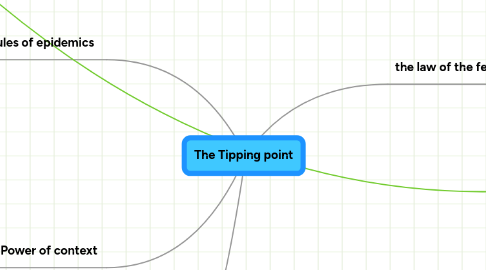
1. rules of epidemics
1.1. contagious
1.1.1. geometric prgression
1.1.2. anti-crime virus
1.1.2.1. new york crime
1.1.2.1.1. broken window theory
1.1.3. many small groups
1.1.3.1. magic number 150
1.1.3.1.1. limit to intellectual capacity
1.1.3.1.2. peer pressure
1.1.3.1.3. gore case study
1.2. little changes big effects
1.2.1. 20 kids started international trend
1.2.1.1. hush puppies success
1.3. dramatic
1.3.1. demolition of high rises
1.3.1.1. Baltimore syphilis outbreak
1.3.1.1.1. breakdown of medical services
1.3.1.1.2. increase in crack
1.3.1.2. spreading of infected population
1.3.2. 80/20 ratio
1.3.2.1. car accidents
1.3.2.2. Boss man case study
2. Power of context
2.1. environment
2.1.1. conditions and circumstances
2.1.2. graffiti,crime infected tubes
2.1.2.1. Bernard Goetz
2.1.2.2. Reduction of graffiti
2.1.2.2.1. Reduction of crime
2.1.2.2.2. Breakdown on fare beating
2.1.2.2.3. Change of message sent out and attitude
2.2. influences how we feel
2.2.1. cell block experiament
2.2.2. terrifying atmosphere-fight or flee?!
2.3. New node
3. Stickiness Factor
3.1. once advice is practical and personal it becomes memorable
3.1.1. Images/maps
3.1.1.1. Student Tetnis advertisement campaign
3.2. context of message matters
3.2.1. we can only read small amounts of text at a time
3.2.2. understandability
3.2.2.1. clarity
3.2.2.1.1. Blues clues
3.2.2.2. no confusion or hype
3.2.2.3. distractions
3.2.2.4. what kids don't understand they don't pay attention to.
3.2.3. sesame street
3.2.3.1. tried to appeal to children and adults
3.2.3.2. wanted to educate kids from deprived backgrounds so they had an advantage before preschool
3.2.3.3. mixed fantasy and reality to get the kids to engage
3.2.3.4. Joan Gantz Cooney started it
3.3. packaging of information matters
3.3.1. right circumstances
4. the law of the few
4.1. connectors
4.1.1. paul revere
4.1.1.1. american revolution
4.1.1.1.1. midnight 19th april, 1775
4.1.1.1.2. Boston Harbour to lexington
4.1.1.1.3. Word of mouth epidemic
4.1.1.1.4. surprised the British by the unsuspecting attack
4.1.1.2. silversmith
4.1.1.3. connected with all 7 regiments
4.1.2. Roger hardow
4.1.2.1. Collects people like others would collect stamps
4.1.2.1.1. keeps a book of people he's met birthdays and anniversaries
4.1.2.2. is happy to be have shallow friendships
4.1.2.3. Natural gift
4.1.3. 6 degress of separation
4.1.3.1. Rod Steiger
4.1.3.1.1. Most connected actor in history
4.1.3.2. surname experiament-same life situations yet varying numbers from 9-108 prove its a natural gift
4.1.4. have their feet in many niches
4.1.5. allow others access to niches they don't naturally belong in.
4.1.6. are naturally interested in others
4.1.7. Lois weisberg
4.1.7.1. commissioner of cultural affairs in chicago as well as many other careers.
4.1.7.2. Helen Doria 'lois sees things in you that you don't see in yourself'
4.2. salesmen
4.2.1. persuasive
4.2.2. skilled
4.2.2.1. Builds up trust in 10 mins
4.2.3. likeable
4.2.3.1. Charming
4.2.3.2. case study of the news readers and political influence
4.2.4. Tom Gau
4.2.4.1. subtle actions are persuasive
4.2.4.1.1. case study of onfluences of 'yawning'
4.2.4.1.2. test on students- asked to do certain movememnts while listening to a debate on tuition fee's....resulting in an influence of opinion
4.2.4.2. Rhythmic body language
4.2.4.2.1. emotions are outside in
4.3. innovators
4.3.1. start trends
4.3.2. are different
4.3.3. don't just slide from one group there is a chasm between them
4.4. translators
4.4.1. apply their own take to something
4.4.2. make it usable
4.4.3. take information and ideas from a highly specialized world and translate them into a language the rest of us can understand
4.5. marvens
4.5.1. gathers of information
4.5.2. networkers who pass information on
4.5.3. experts of information
4.5.4. want to help people
4.5.5. are teachers
4.5.6. Mark albert
4.5.6.1. Linda price
4.5.6.1.1. marketing proffessor
4.5.6.1.2. University of Nebraska
4.5.6.1.3. Pioneer in Marven Research
4.5.6.1.4. interviews marvens like mark albert
4.5.6.2. quoted as 'unselfish'
4.5.6.3. economist
